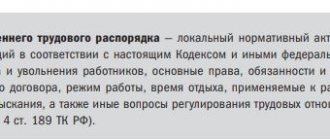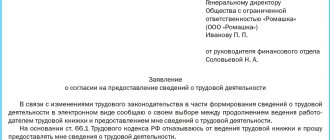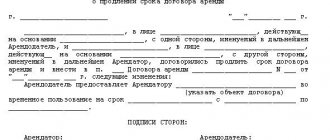What it is
In accordance with the ToR, each employee can be employed by more than one employer.
In such a situation, one of the workers’ places will be the main one, and the second one will be additional. In this case, the worker enters into a separate agreement at each place of work.
The law does not prohibit combinations, taking into account that additional employment. jobs does not exceed sixteen hours a week. Part-time work can be different:
- Internal part-time work is possible when a person holds 2 positions within one organization;
- External part-time work – the employee is employed by different legal entities. persons
However, you should not compare combination and part-time work. The combination is called additional. work when the auxiliary place of work coincides with the main one.
Part-time work involves several additional functions. working hours outside the main workplace. Combination is considered to be the execution of additional business duties during main working hours. It is worth figuring out whether the general director can fulfill his duties part-time.
How to calculate a part-time business trip?
A business trip to an additional place of work involves issuing an order, certificate and official assignment. The manager is obliged to count the days of a business trip, despite two positions held by an employee on the territory of one organization, at the place of work to which the worker goes on a trip. Those days that are considered working hours are subject to payment. Moreover, the amount of such payments must be agreed upon in advance by the parties.
The calculation of the monthly salary is reproduced according to the approved model, which is enshrined in the legislation of the Russian Federation. Before calculating the amount of remuneration, the manager must remember that the amount should not be lower than the minimum wage.
Similar
An employee is entitled to days off from work to conduct a wedding. How much vacation is legally required for...
Any violation of the internal regulations of the organization, norms and rules, as well as current laws entails...
Fixed-term agreements have their own characteristics. One of them is an additional basis for terminating the agreement.…
Every enterprise periodically lays off workers. The wording of this action is simple and means termination of employment...
Few people know that temperature conditions have a significant impact on the health and performance of employees...
Many companies are looking to expand their customer base in order to achieve better work results. And in many ways...
No matter how strong the spirit of camaraderie and mutual assistance is in the company, almost always when asking a colleague for help, an employee formally has the right to say: “This is not my job.” It’s a completely different matter if the expansion of functionality is formalized. In the Rabota.ru material you will find step-by-step instructions for completing the combination and a warning about possible problems.
Combining positions often becomes inevitable to replace an important employee who has gone on vacation, especially maternity leave. It can also be useful for survival in difficult times for a company, especially in conditions of labor shortage. How to arrange a combination correctly?
Director
In the Labor Code a separate chapter is devoted to the work of management. Article 276 tells whether the law provides for part-time work for senior managers. The main limitation in this case concerns external part-time work.
It turns out that the general director is prohibited from holding a position in another company in the absence of official permission, which is issued:
- A person representing the interests of the owner;
- The owner of the company;
- Authorized bodies.
Such restrictions are set by law to protect the rights of the company. The owner must be confident that the CEO will not harm operational efficiency and will improve overall performance.
Calculation of remuneration for work when combining positions
For a combined position, a tariff rate of 135 rubles/hour has been determined. The salary of an employee for the main position in this case will be 19,320 rubles. (115 rub./hour x 168 hours). Additional payment for combination - 11,340 rubles. (135 rub./hour x 168 hours x 50%). That is, the total salary will be equal to 30,660 rubles.
The salary at the main place of work will be 19,320 rubles. (115 rub./hour x 168 hours). Additional payment for combination - 11,000 rubles. (RUB 22,000 x 50%).
The total salary will be 30,320 rubles. ((19,320 11,000) rub.). So, we have examined the main features of part-time work and the procedure for remuneration in this case.
If an employer offers additional work (internal part-time work), you need to remember the following: 1.
On the minimum wage";
- Decree of the Government of the Russian Federation dated July 22, 2008 No. 554 “On the minimum amount of increase in wages for work at night”;
- Decree of the Government of the Russian Federation dated December 24, 2007 No. 922 (as amended on December 10, 2016) “On the specifics of the procedure for calculating average wages”;
- Federal Law of November 24, 1995 No. 181-FZ (as amended on June 1, 2017) “On the social protection of disabled people in the Russian Federation”;
- Decree of the Government of the Russian Federation dated October 13, 2008 No. 749 (as amended on July 29, 2015) “On the specifics of sending employees on business trips,” etc.
https://youtu.be/ui7Uf1ZUQHw
According to Art.
At the same time, the employer is free not only to follow generally accepted standards, but also to establish his own calculation procedure. For example, a part-time worker may be given a fixed salary without taking into account the actual time worked. But regardless of the form of remuneration, a part-time worker is entitled to all regional coefficients and allowances applicable to main employees.
If a part-time worker works four hours a day every day, then he is given a rate of 0.5%. For lower daily output, a lower rate is established.
Internal alignment
If we consider the internal type of combination, then the legislation does not provide for any restrictions. But internal combinations are prohibited for heads of supervisory authorities in order to avoid dependence on unpleasant circumstances.
But the law cannot prohibit a manager from being a member of the supervisory board, since this body does not exercise control functions.
ATTENTION! Similar restrictions apply in situations where the CEO is not the owner of the company.
Nuances of part-time work
External and internal part-time work are regulated by the same articles in the TCRF (Articles 60, 282–288 and 329). The law states that any person can, in his free time from his main job, conduct other activities and take on additional responsibilities in the amount that he physically can perform in a working day/week/month. That is, in fact, there are no restrictions - you can take on any part-time job if you are physically able to pull it off. Moreover, there are cases when a person arranges a part-time job, working not just in the same company, but also in the same position. For example, a manager can take over the work of a second manager or part of it (usually, if a third colleague is fired, the remaining two take over his responsibilities). Or a teacher who teaches physics takes hours of astronomy, etc.
Attention:
combination is possible only if the employee agrees to take on an increased workload. The manager cannot force him to sign a new agreement or contract.
To take on job responsibilities, you must write an application addressed to the manager and obtain his consent. Management is usually happy to hire part-time employees, especially if the person has proven himself to be a good employee - it is better for him to work with a well-known, normal employee than to search for a new one and create risks.
Part-time workers are subject to all rules in force in the organization
Reasons for refusal
Certain categories of employees are prohibited from working part-time. These include:
- Workers who are not yet 18 years old;
- Government employees;
- Workers who perform their duties in aggressive conditions;
- Citizens who transport passengers.
These restrictions are established by Art. 282.329 Labor Code of Russia. The above restrictions apply not only to ordinary workers, but also to senior managers.
Do not forget that employees holding senior positions in government agencies are prohibited from working part-time in commercial organizations. These restrictions are set not by the Labor Code, but by the federal laws “On Civil Service” and “On Municipal Service”. Similar restrictions apply to Central Bank employees.
ATTENTION! There is also an important point: each individual company has the right to establish a ban on part-time work for its employees within the framework of trade unions. Such a procedure should be enshrined in the organization’s charter.
Labor Code of the Russian Federation and internal combination of positions
Internal combination of two professions mainly differs from combining positions by an employee in that, according to the current Labor Code of the Russian Federation, he works in an organization, in addition to his main job, and also in an additional vacancy at the very time when he is not busy with his main professional activity. These features are prescribed in Art. 282, 60.1 Labor Code of the Russian Federation.
Certain clauses of the Labor Code of the Russian Federation impose certain restrictions affecting the total amount of time that an employee can spend on combining two professions. If a person combines two positions in one organization, then the law allows him to devote no more than 4 hours a day to the second job.
Within one month, an employee can work in additional work no more than half the time spent in his main position. In some cases, an employee may ignore this restriction.
Important: If on some day a person in his main position has a day off, he can devote the entire working day to his second job.
Entry in the work book
Registration of internal part-time work
The process of registering an internal part-time job involves drawing up an additional agreement to the existing main employment contract. At the same time, it must be taken into account that it is permissible to impose on such an employee all the requirements that are imposed on other employees who do not work part-time in several positions.
An internal part-time worker must have two employment agreements with the employer, for his main vacancy and for an additional one.
This is interesting: Registration on the State Services portal
The employment contract and additional agreement must contain the following information:
- Name of the organization;
- The exact name of the position that the employee will additionally occupy;
- Description of the remuneration system for an employee of an organization working part-time in several positions;
- Opening hours and weekend schedule.
According to the current rules and regulations, such an agreement is drawn up in writing and in two copies.
Important: The main employment contract must indicate that the employee works in two positions at the same time, according to internal part-time work.
Step-by-step instruction
The first step is preparing the position. If we talk about combining positions (as opposed to increasing the service area), then the following conditions must be met:
- the position must be on the staff schedule;
- the position must be considered vacant.
The final condition does not follow directly from the requirements of the Labor Code, but is often taken into account by courts and inspectors. Sometimes a new position is entered into the official schedule specifically for the purpose of combining.
It is worth highlighting that a temporarily unoccupied position is not considered vacant, that is, if the employee replacing it has gone on vacation.
To order additional work of an unoccupied position temporarily, the wording “performing the duties of a temporarily absent employee” is used. The second step is the written consent of the worker.
In accordance with Art. 60.2 Labor Code of Russia add. work can be entrusted to an employee only with his consent. Such consent is formalized in 2 ways:
- At the request of the employee , he writes a petition with a request to transfer the functions of the chosen position to him in order to combine the functions of the chosen position. For example, in the order of expanding the zone or in the order of performing manipulations by a temporarily absent worker.
- At the suggestion of the management , a report is drawn up from the head of the department with a request to transfer the responsibilities of the combined position to the worker. In turn, the worker supplements this note with his official consent on signed paper. Then a management resolution is imposed.
The report may already contain an indication of the period of combination if it will be issued for a specific period. The third action is additional. agreement to the employment contract.
The combination affects the employee’s work responsibilities, and they are considered the subject of TD. It turns out that the combination will require an additional agreement with the worker. agreements to the main contract. The agreement must contain the following parameters:
- Additional type work (part-time position, performing manipulations for a temporarily absent worker).
- Deadline for additional implementation work (after all, it can be different).
- Contents of additional labor, that is, auxiliary labor functions.
- If the provoking factor for the preparation of additional. The contract became a statement by the worker, indicating that duties are imposed on a person at his request.
Fourth action, order for personnel.
The basis for such part-time work is considered to be a special order for personnel. It is issued on the basis of additional agreements in free form on the form of orders for drugs. In any case, the order must contain the following:
- Type of additional work.
- The position by which the combination is determined (if the auxiliary work is assigned in this order).
- Additional deadline work.
- Contents of additional work.
- A predetermined amount of payments for additional payments. work.
- Other conditions (if truly required).
Special conditions are a completely new responsibility or other powers necessary to fulfill additional requirements. functions.
For example, for the position of cashier there is a material type of responsibility, for workers in the personnel department - responsibility for all official documentation, for management - the authority to sign and the right to make official management decisions.
Establishing a combination of professions (positions) allows the organization to complete the required amount of work without hiring a new employee. Combining professions (positions) improves the employee’s qualifications and increases his income.
The rules on combinations are contained in Chapter 6 of the Labor Code, which regulates wage issues. In other chapters of the Labor Code, issues of combining professions (positions) are not considered.
Combination of professions (positions) is understood as the performance by an employee of the same employer, along with his main work stipulated by the employment contract, of additional work in another profession (position) without exemption from the work specified in the employment contract (job description), including during the working hours established for the employee <*>.
There are the following types of combination <*>:
— combination of professions (set by the worker);
— combination of positions (established for employees and specialists).
Combination of professions (positions) can be used if there is a vacancy in the staffing table for a certain profession or position. And also in the temporary absence of an employee performing work in a given profession (position). For example, in case of temporary absence of an employee due to temporary disability, vacation, advanced training, performance of state or public duties, and for other reasons, when, according to the law, his place of work (position) is reserved.
In addition to combination, additional payment can be established <*>:
— for expanding the service area;
— increase in the volume of work performed;
— fulfilling the duties of a temporarily absent employee.
Expanding the service area and increasing the volume of work performed means that an employee, along with the work specified in the employment contract (job description), performs additional work for the same vacant position of an employee (worker's profession) during the working hours established for the employee.
The performance of the duties of a temporarily absent employee without release from his main job should be understood as the employee’s performance, along with the work specified in the employment contract (job description), of additional work both in another and in the same position of the employee (worker’s profession) to replace an employee who is absent due to illness, vacation, business trip and other reasons, when, in accordance with current legislation, his workplace (position) is retained.
Combining professions (positions), expanding the service area, increasing the volume of work performed, and performing the duties of a temporarily absent employee are carried out:
- only with the consent of the employee;
- without releasing the employee from his main job;
- within the limits of the duration of the working day (shift) established by law for work stipulated by the employment agreement (contract);
— without concluding another employment agreement (contract);
- with the establishment of an appropriate surcharge.
An agreement on combining professions (positions) is drawn up by order (instruction) of the employer indicating the combined profession (position), the volume of additional functions or work performed and the amount of additional payment. This order also indicates the deadline for completing work when combining professions (positions), if the combination is established for a certain time <*>.
If the performance of combined work requires appropriate education or special training or a medical examination, then the employee is obliged to submit an appropriate document granting the right to perform this work, or a certificate of passing a medical examination <*>.
The combination can be set:
both when applying for a job and during the work process;
for an indefinite period (permanently) and for a certain period (temporarily);
by positions and professions belonging to different categories of workers. At the same time, it is advisable to establish a combination of professions (positions) similar in profile to the main job.
Combination should be distinguished from the employee performing other work due to production necessity. In this case, the employer has the right to transfer the employee for a period of up to one month to a job not stipulated by the employment contract in the same organization with wages for the work performed, but not lower than the average earnings for the previous job. This translation is allowed <*>:
— to prevent a catastrophe, industrial accident or eliminate the consequences of a catastrophe, accident or natural disaster;
— prevention of accidents, downtime (temporary absence of work due to an economic, technological, technical or organizational nature), destruction or damage to property, etc.;
— replacing a temporarily absent employee.
Production needs arise unexpectedly, and the further normal activities of the organization or its divisions depend on the implementation of urgent work. Therefore, if there is a production need, the employee’s consent is not required to entrust him with such work.
Refusal to perform work to which the employee was transferred due to production necessity is a violation of labor discipline; accordingly, the employee may be subject to disciplinary liability <*>.
If there is a production need, the employee is transferred to another job, that is, he is released from performing his work under the employment contract. When combining professions, the employee performs both his work under the employment contract and additional work in another profession (position) <*>.
Combination should also be distinguished from internal combination. With internal part-time work, additional work is performed under another employment contract, valid in parallel to the main one. When combining, additional work is performed without concluding another employment contract on the basis of an order establishing a combination <*>.
Part-time work is performed within normal working hours. Part-time work is allowed only during free time from the main job <*>.
Payment for part-time work is made in proportion to the time worked or for the actual work performed. When combining professions, an additional payment is made to the employee <*>.
The amounts of additional payments for combining professions (positions), expanding the service area (increasing the volume of work performed) or performing the duties of a temporarily absent employee are established by the employer by agreement with the employee. Typically, such additional payments are established by the employer within the tariff rate (salary) of the absent employee, depending on the volume of work performed <*>.
For budgetary organizations and other organizations receiving subsidies, whose employees are equal in wages to employees of budgetary organizations, the maximum amount of such additional payments is the tariff rate (salary) of the absent employee, depending on the volume of work performed. In this case, the specified additional payments are not established <*>:
— heads of organizations, their deputies (with the exception of heads of preschool education institutions, special preschool institutions and their deputies);
— scientific workers of research organizations (divisions);
- in cases where combined work is provided for in labor cost standards, stipulated by an employment contract (included in the employee’s duties) or is assigned to the employee in the manner prescribed by law due to insufficient workload in the main job.
For reference, the list of other organizations receiving subsidies, whose employees are equal in wages to employees of budgetary organizations, was approved by Resolution of the Council of Ministers No. 14.
When establishing additional payments, the complexity, nature, volume of work performed and the overall workload of the employee should be taken into account. The additional payment can be set either in a fixed monetary amount or as a percentage of the monthly tariff rate (official salary) for the combined profession (position).
If responsibilities for a vacant profession (position) or in the temporary absence of an employee are assigned to several employees, then additional payments are established for each of them.
Additional payments paid to employees for part-time work are included in the average earnings in all cases of calculation (for payment of vacations, for days of temporary disability, for calculating pensions and in other cases) <*>.
The establishment or cancellation of a combination does not constitute a change in essential working conditions. Therefore, the employee has the right to refuse to perform additional work, and the employer has the right to cancel the order to perform it at any time <*>.
Payment
Article 60.2 of the Labor Code of Russia states that additional work is paid for combination work. Additional size payment, in accordance with Art. 151 of the Labor Code of the Russian Federation, is set by agreement of the parties. Add. payment is credited in accordance with the hours actually worked, that is, if the employee did not combine positions for the entire month, then auxiliary payment is credited only for the time of combination.
IMPORTANT! If you remember simple rules and laws, it will be much easier to solve problems related to part-time work.
Terms of combining positions
The legislation does not establish the maximum and minimum duration of combining positions, so the decision on this issue remains with the employer, however, the agreement on combining positions must necessarily indicate the period during which the employee will perform additional duties.
When discussing issues of combining, the employer and employee come to a common term for combining, or the employer determines in advance the period necessary for carrying out additional work. In any case, it is specified in the agreement. If necessary, another additional agreement may be concluded with the employee for any period.
An employer can offer a combination of jobs either for one month or for a year. Moreover, if necessary, each of the parties can terminate the agreement by warning the other three days before the refusal to work. The notification must be sent in writing and must be familiarized with by the other party.
Part-time work differs significantly from part-time work; understanding the distinctive features and proper design will save both the employee and the employer from additional problems such as inspections by the labor inspectorate or tax authorities.
Options for combining jobs and positions in an organization
Under the concept of “combination”, disclosed in Art. 60.2 of the Labor Code of the Russian Federation, a fairly large number of additional work functions performed during official time are covered:
- increasing the volume of work for the same position and specialization (for example, performing work for two similar positions in one department in the absence of a second employee);
- performing work for a temporarily absent colleague (for example, for an employee on maternity leave);
- combination of positions or professions (in essence, these are the same thing, but the term “profession” is more often used for working or technical areas, and “position” for management and specialists).
Read about the essence of the difference between internal part-time and internal combination in the material “Registration of combining positions in one organization.”
On our forum you can ask any question you have while working with personnel documents. For example, here we discuss how to formalize the combination of positions in the 1C program.
Sample order on combining positions (according to the unified form KP-152)
The current regulations do not establish a unified form of order for combining positions.
The HR manager has several options:
- Draw up an order in free form, taking into account all requirements and circumstances.
- Finalize the form approved by Goskomstat (usually they take the T-1 form and include additional parameters in it).
- Take advantage of the legacy of the USSR (in those parts that do not contradict current laws). In addition to detailed instructions for registering combinations (which are mostly used now), in the USSR there was a form of order for personnel KP-152 for combining positions (professions). If such a form is used, it must be approved for use within the organization. To do this, the head of the organization places an approval stamp in the upper right corner of the document.
The proposed sample order for combination is drawn up according to the KP-152 form.
Finally, the final stage of registration of combining positions is the issuance of a corresponding order.
Like other documents discussed above, the order is drawn up in free form; there is no unified form.
READ MORE: Lithuania citizenship law Advisor
The order must duplicate all the conditions for combining positions agreed upon by the parties: the type of work assigned and its content, the period for which the combination is expected, as well as the amount of the agreed fee for performing additional work.
The order is issued on the basis of a signed agreement between the parties to perform additional work.
The employee must be familiarized with the order against signature.
After signing the additional agreement, the company should issue a corresponding order.
Russian labor legislation does not contain a specific unified form for such an order.
At the same time, it should indicate which positions the employee will combine, for what period and for what additional payment. In this case, as a basis for combination, the order must specify the details of the additional agreement drawn up with the employee.
Article No. 60.1 of the Labor Code of the Russian Federation states that part-time work is defined as the ability of each employee to enter into additional contracts to formalize labor relations during hours not occupied from the main job. They are regulated by Chapter No. 44 of the Labor Code of the Russian Federation.
There are two types of combination: internal and external. Let's take a closer look. What's the difference?
The main difference between external part-time work is the formalization of labor relations with a third-party employer different from the main one. The employee performs his/her job duties during non-permanent work hours. The number of hours of part-time work should not exceed 50% of the main working day (usually 4 hours).
Internal part-time work includes the organization of contractual relations with the main employer. The contract is drawn up according to the same rules as for an external one. To combine, it is necessary to conclude an additional employment contract.
Some categories of citizens do not have the right to be part-time workers:
- minors;
- when working in hazardous working conditions, those who have such restrictions at their main place;
- state and municipal employees.
Below you can familiarize yourself with the step-by-step procedure for hiring a part-time worker.
Features of combination design
If a specialist is able to perform duties in two positions at the same time, it is better to formalize the combination. But you need to take into account that a person must have time to do everything described in the job description.
If you need to move from one building to another or have other problems, it is better to arrange an internal part-time job. An additional agreement to the part-time employment contract, a sample of which is available on the website, is necessary to regulate all aspects related to the performance of duties in the second position.
Drawing up a part-time employment contract with an employee includes the creation of an additional agreement. This document must indicate the responsibilities that the specialist will assume and how long he will perform them. In this matter, it is necessary to be guided by Article 72 of the Labor Code of the Russian Federation. Naturally, the worker will receive additional monetary remuneration, which will also be specified in the code.
To legally fulfill the duties of combining positions, the following documents must be available:
- a job offer from a company to an employee;
- statement written by the employee.
Important ! The work book remains unchanged and only the main positions are recorded in it.
An employment contract with a combination of positions, a sample of which can be downloaded, is usually concluded for a short period. It is logical that the question often arises as to whether it is necessary to record the time spent by the employee.
The law establishes that time for two positions when combined is not divided. Therefore, when filling out the timesheet, the main hours of work are taken into account. Naturally, after the additional agreement is signed, it is necessary to organize the issuance of an order. There is nothing specific in the legislation on this matter. Therefore, the order must reflect information about the time of combining positions, functions performed and other important features.
The order must also contain information about the additional agreement drawn up. Upon expiration of the contract, the employee simply ceases to perform the functions of the second position. Drawing up additional documents or terminating the contract is not required. If the agreement is extended, a new order must be issued.










